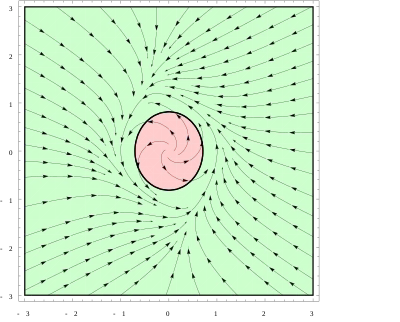Bendixson–Dulac theorem
In mathematics, the Bendixson–Dulac theorem on dynamical systems states that if there exists a function (called the Dulac function) such that the expression

has the same sign () almost everywhere in a simply connected region of the plane, then the plane autonomous system
has no nonconstant periodic solutions lying entirely within the region.[1] "Almost everywhere" means everywhere except possibly in a set of measure 0, such as a point or line.
The theorem was first established by Swedish mathematician Ivar Bendixson in 1901 and further refined by French mathematician Henri Dulac in 1923 using Green's theorem.
Proof
Without loss of generality, let there exist a function such that
in simply connected region . Let be a closed trajectory of the plane autonomous system in . Let be the interior of . Then by Green's theorem,
Because of the constant sign, the left-hand integral in the previous line must evaluate to a positive number. But on , and , so the bottom integrand is in fact 0 everywhere and for this reason the right-hand integral evaluates to 0. This is a contradiction, so there can be no such closed trajectory .
References
Henri Dulac (1870-1955) was a French mathematician from Fayence
- Burton, Theodore Allen (2005). Volterra Integral and Differential Equations. Elsevier. p. 318. ISBN 9780444517869.